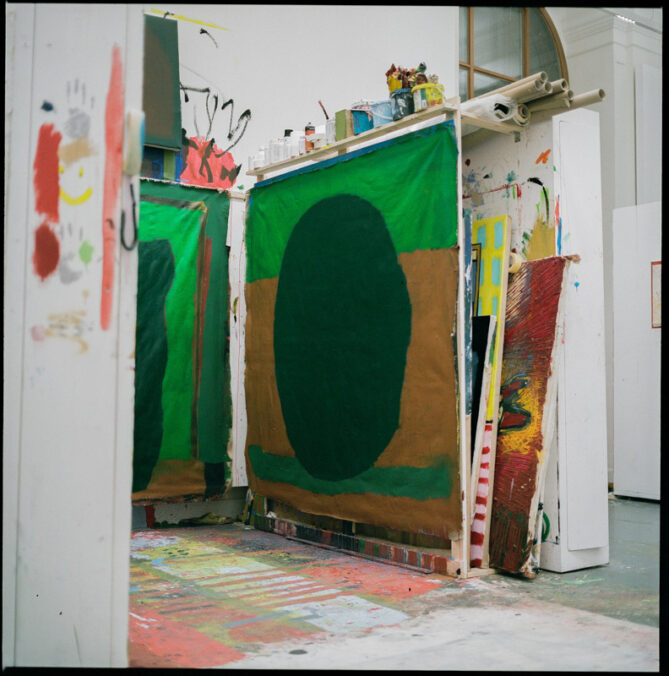
I found your room at Parallel Art Fair exciting and cosy – it felt a bit like a living room atmosphere and the wolves and cowboy motives around didn’t scare me. Tell us something about your compositions, the figure of Wolf is so present in your work. Why does it keep repeating and repeating?
First of all, I am glad to hear that. Actually, I think that it is quite important to experience my work properly, to have it cozy, to be invited. And being able to sit is a nice extra. I am the first at the museum who sits down. Another reason why, we (my Team and I) wanted to create a unique room, something that stands out. The wolf first appeared a couple of years ago, when I dived into depicting animals. Unclear in the beginning, the wolf took on more and more of an identity and is now, and in retrospect has always been, the personification of nature. So the wolf is something very positive to me; in my paintings, he wouldn’t eat Red Hood, he’s the good one.
How did it feel the Otto Wagner Pavillion/ Areal? What role does the site play in your work?
I don’t have a particular connection with the Areal, but Otto Wagner’s architecture is of course beautiful and mesmerizing. More important to me was the nature there. It felt like my work found a well-suited, temporary home.
My wolf could really live at Baumgartner-Höhe.
You are studying Abstract Painting in the Michaela Eichwald and Thomas Winkler class. What is their approach to painting?
Michaela and Thomas have a very unique approach to painting and art in general, each on their own. However, they would never impose their style or methods onto students. We are more or less free to do as we please. They will give us feedback, but not as in „that was good“ or „that was bad“, rather they analyse our approach and give us some food for thought. Which sometimes might sound harsh, and I have often rejected their initial feedback, but after contemplating for a while, I’d always come around and appreciate it tremendously. After all, they are professors for a reason.
What formats of works do you like Lukas?
For basically ever, I have been a huge fan of large scale formats. Everything is beyond 160 x 160 cm. That changed last semester. I was doing my Erasmus abroad and took a little bit of a break from painting, did more sketch work, ceramics and dabbled with Affresco. To sum up, I did what I wanted, and it felt great, and still does. Pared with my atelier becoming less and less spacious, because of the large paintings, the cost of producing those, and the difficulty of exhibiting big canvases, I am thinking about downsizing. However, I want to venture into sculptural work, so that could thwart my efforts again. I also don’t like to set myself any limitations, whatever I create, I create.
What are you currently working with for example?
For the last couple of weeks, I have only been drawing, with pencil and or pen, on paper. Some plaster work plans are also in the making, but nothing concrete yet. But as I said, there is no way of knowing what will come next. Woodworking and blacksmithing have been on my agenda as well.

O.T., Lack, Acryl und Öl auf Mischgewebe, ca. 210 x 230 cm
While watching your CV, I got stuck at a period when you were working as a museum guard at Albertina. How did it feel? Me myself I imagine it as super romantic to be in such an environment. Did you have a painting that you were feeling very connected and inning?
It does sound very romantic, on paper. In reality, it is a lot of standing around. We were not allowed to sit, had short breaks and the visitors would always be too close to the artworks. Therefore, focusing on the paintings wasn’t an option, at least not all the time. I still tried, of course. I would often be in one of the main collections, where among others Kandinsky, Monet, Picasso, Klee, Malewitsch and Baselitz would be exhibited, to mention some of my favourites. Besides the paintings, there was something else that I took from my time at the Albertina: All the great artists have that confidence in their, for example, brush work. It seems like they are always completely content with exactly this stroke, that line, that splash that they had just made. From then on, or a little bit after, I have been seeking that confidence, and I must say I have been finding it more and more. I don’t want to toot my own horn here, rather I want to say that I have more confidence in what I do. I trust myself. It’s hard to explain; and it still needs a lot of reflection and thinking. It’s not getting easier, maybe I am just happier.
Other important artists to you?
Right now, the most influential artists to me are Philip Guston, Denise Rudolf Frank, Mark Rothko, Yves Klein and Cy Twombly.
Lukas Soldo – www.instagram.com/lukassoldo
Lukas Soldo (*2001, Vienna) lives and works in Vienna, where he attends the Academy of Fine Arts, under Michaela Eichwald and Thomas Winkler in the Abstract Painting class. In his works, he endeavors to let his subconscious guide him. Little planning precedes the painting, and the meaning is often found during the painting process. His paintings vary between two states: Figurative paintings which tell stories using his self-created characters, namely the Wolf and the Cowboy, and on the other hand abstract works where he likes to play with color, space, and form to create something, as he says „complete „.








